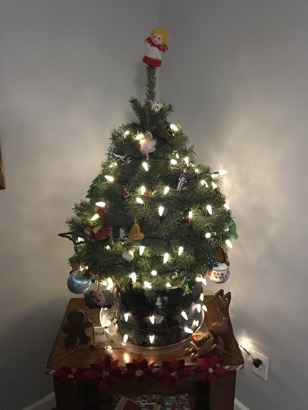A little tree
15/12/22 01:09

The trees in the Slim Buttes were mostly Ponderosa Pines, which aren’t always shaped like the fir and spruce trees that come from Christmas Tree farms. That didn’t bother us. We enjoyed the trees and had fun decorating them.
We continued the tradition of cutting our own tree when we moved to Boise, Idaho, which is close to the national forest. There were years during our decade in Idaho when we purchased trees from vendors. Those trees had come from tree farms. Tree farms generally harvest trees at or around 10 years of age, which means that they harvest and replant about 10% of their crop each year.
When we moved to South Dakota, however, the forest was so close and the joy of moving out of the city into a more rural location lured us to the forest each year. We have some stories of adventures of tree cutting, including spending the night in our pickup once when the starter failed. Our last year in the Black Hills, Susan was recovering from a hospitalization, and we considered buying a tree from a lot, but we found a day when she was feeling well and headed out into the hills to collect our last Black Hills Christmas tree. It was a wonderful adventure and the tree added to the delight of having each other and having Susan’s health return.
When we moved out here, we started a new tradition. We purchased live trees with root balls from a nursery and planted the trees at our son’s farm, where they are trying to increase the number of trees in certain areas to help with water absorption and retention. It was an amazing experience last year to plant a Douglas Fir tree and to watch it grow throughout the year. Thinking that the tree that was part of our first Christmas in our new house will one day grow to a height of 100 feet or more and will outlive us by many decades is a humbling, yet exciting proposition. I check on that tree every trip I make to the farm.
One of the things about having a tree you intend to plant as a Christmas tree is that you have to be responsible about caring for the tree. Trees grow best outdoors in the natural weather. Bringing one inside in the middle of winter can cause it to need extra water and resources when few are available in the natural setting. Last year we brought our tree indoors for a few days and then moved it to our front porch where it stayed for a while before it was time to plant it.
This year is different. We will be traveling a few days after Christmas, so the tree will move out of the house right after Christmas. The winter has been especially mild this year, and some nurseries are recommending planting the trees right away after they are part of the celebrations.
We decided to purchase a dwarf tree that is small enough to be part of the landscaping at our home, rather than a larger tree to plant at the farm this year. The result is that we have a much smaller tree than usual. It is a delightful little dwarf Alberta spruce and we have just the right spot for it at the edge of our yard. The mature tree will be only about 6 feet tall with a 4 foot circumference.
For many years we have had more ornaments than we have room on our Christmas tree. This is our 50th Christmas since we were married. We’ve had time to collect a lot of ornaments. In addition to the tree, we string lights on the top of our bookshelves and hang ornaments there. We put ribbons on the bannisters and sometimes display a few ornaments in other places around our house. We have a modest collection of nativity sets that get put out around the house while other knick knacks are put in temporary storage for the holiday. Having a small tree means that we might not take every ornament out of storage this year, but as usual, we got out all of our boxes and went through the ornaments one by one, remembering and enjoying the many stories that surround the decorations.
Compared with many of our neighbors our decorations are modest. We’ve never been into displays of outdoor lights. We’re content with a few meaningful decorations inside our home.
I recently read an article about the debate between advocates of artificial trees and real trees. In the United States, an estimated 25 - 30 million real trees are sold annually. Since most of them come from tree farms, most of the trees have other trees planted in their place. When we cut trees from the national forest, we were careful to observe guidelines and to harvest trees from places where there were plenty of seedlings growing. Often we cut our tree from a cluster where not all of the trees could survive to maturity because they were growing too close to one another. I don’t have much to offer to the debate, but we have never owned an artificial tree and have no intention of obtaining one. We like the idea of planting our tree after enjoying it inside our home. Nurturing living things and inviting them into our home gives us joy. Storing a plastic object in a box except for a few weeks each year just isn’t our style.
This year, we are very happy with a little tree. It seems just right for us and our style of celebrating.
